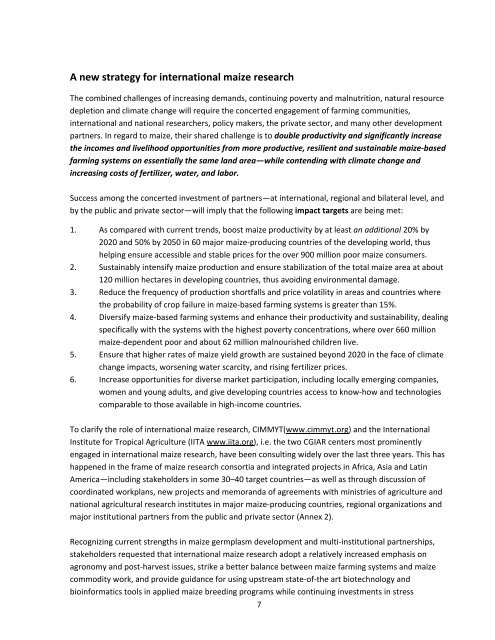Download - Maize
Download - Maize
Download - Maize
You also want an ePaper? Increase the reach of your titles
YUMPU automatically turns print PDFs into web optimized ePapers that Google loves.
A new strategy for international maize research<br />
The combined challenges of increasing demands, continuing poverty and malnutrition, natural resource<br />
depletion and climate change will require the concerted engagement of farming communities,<br />
international and national researchers, policy makers, the private sector, and many other development<br />
partners. In regard to maize, their shared challenge is to double productivity and significantly increase<br />
the incomes and livelihood opportunities from more productive, resilient and sustainable maize‐based<br />
farming systems on essentially the same land area—while contending with climate change and<br />
increasing costs of fertilizer, water, and labor.<br />
Success among the concerted investment of partners—at international, regional and bilateral level, and<br />
by the public and private sector—will imply that the following impact targets are being met:<br />
1. As compared with current trends, boost maize productivity by at least an additional 20% by<br />
2020 and 50% by 2050 in 60 major maize‐producing countries of the developing world, thus<br />
helping ensure accessible and stable prices for the over 900 million poor maize consumers.<br />
2. Sustainably intensify maize production and ensure stabilization of the total maize area at about<br />
120 million hectares in developing countries, thus avoiding environmental damage.<br />
3. Reduce the frequency of production shortfalls and price volatility in areas and countries where<br />
the probability of crop failure in maize‐based farming systems is greater than 15%.<br />
4. Diversify maize‐based farming systems and enhance their productivity and sustainability, dealing<br />
specifically with the systems with the highest poverty concentrations, where over 660 million<br />
maize‐dependent poor and about 62 million malnourished children live.<br />
5. Ensure that higher rates of maize yield growth are sustained beyond 2020 in the face of climate<br />
change impacts, worsening water scarcity, and rising fertilizer prices.<br />
6. Increase opportunities for diverse market participation, including locally emerging companies,<br />
women and young adults, and give developing countries access to know‐how and technologies<br />
comparable to those available in high‐income countries.<br />
To clarify the role of international maize research, CIMMYT(www.cimmyt.org) and the International<br />
Institute for Tropical Agriculture (IITA www.iita.org), i.e. the two CGIAR centers most prominently<br />
engaged in international maize research, have been consulting widely over the last three years. This has<br />
happened in the frame of maize research consortia and integrated projects in Africa, Asia and Latin<br />
America—including stakeholders in some 30–40 target countries—as well as through discussion of<br />
coordinated workplans, new projects and memoranda of agreements with ministries of agriculture and<br />
national agricultural research institutes in major maize‐producing countries, regional organizations and<br />
major institutional partners from the public and private sector (Annex 2).<br />
Recognizing current strengths in maize germplasm development and multi‐institutional partnerships,<br />
stakeholders requested that international maize research adopt a relatively increased emphasis on<br />
agronomy and post‐harvest issues, strike a better balance between maize farming systems and maize<br />
commodity work, and provide guidance for using upstream state‐of‐the art biotechnology and<br />
bioinformatics tools in applied maize breeding programs while continuing investments in stress<br />
7

















